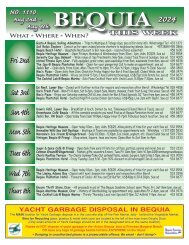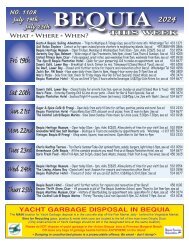Caribbean Compass Yachting Magazine - December 2021
Welcome to Caribbean Compass, the most widely-read boating publication in the Caribbean! THE MOST NEWS YOU CAN USE - feature articles on cruising destinations, regattas, environment, events...
Welcome to Caribbean Compass, the most widely-read boating publication in the Caribbean! THE MOST NEWS YOU CAN USE - feature articles on cruising destinations, regattas, environment, events...
You also want an ePaper? Increase the reach of your titles
YUMPU automatically turns print PDFs into web optimized ePapers that Google loves.
GET TO KNOW YOUR CARIBBEAN MARINE LIFE<br />
CARIBBEAN CRABS Part 2 - The Sea Dwellers<br />
by Darelle Snyman<br />
This month we continue to delve into the lives of these odd-looking creatures<br />
whose sweet-tasting meat is considered a delicacy by many. Crabs themselves<br />
are not picky eaters and these scavenging omnivores will feast on any plant<br />
and animal matter they come across. The feeding habits of one of these<br />
<strong>Caribbean</strong> residents, the <strong>Caribbean</strong> King Crab (Mithrax spinosissimus), might<br />
actually help conserve coral reefs. Seaweeds or macroalgae are key components<br />
of a healthy coral reef ecosystem. Problems start when changing conditions<br />
allow fleshy macroalgae to proliferate at the expense of the other coral reef<br />
inhabitants. The continued decline in herbivorous fish numbers as a result of<br />
overfishing has exacerbated the problem. Seaweed also produces chemicals<br />
that repel larval reef fish and shut down reproduction in corals. Under such<br />
conditions the coral reef ecosystem faces collapse.<br />
The <strong>Caribbean</strong> King Crab<br />
This crusty critter has many aliases: you might know it as the Channel<br />
Clinging Crab, Coral Crab or Reef Spider Crab. This is the largest crab you will<br />
encounter in the <strong>Caribbean</strong> waters. The well-camouflaged <strong>Caribbean</strong> King<br />
Crab in the photo is one of a few individuals I encountered beneath the dock<br />
at El Milagro Marina, Isla Mujeres, Mexico. The algae cover hides its typical<br />
reddish carapace and knobby exoskeleton. In the photo you can clearly see the<br />
characteristic spines and nodules that cover its legs.<br />
The herbivorous role of crabs has not yet been well investigated, but a study<br />
done by Florida International University has shown that the <strong>Caribbean</strong> King<br />
Crab might be one of those herbivore heroes that can create the conditions<br />
needed for coral reefs to recover from macroalgae overgrowth. Its spoonshaped<br />
chelipeds (claw-bearing legs) have been perfectly designed for scraping<br />
algae, its main food source, from coral and rocks.<br />
The <strong>Caribbean</strong> King Crab became the focus of a study because of the rapid<br />
rate at which it consumes seaweed and its appetite for those species of<br />
seaweed that are generally avoided by other herbivores, such as the calcareous<br />
green algae, Halimeda, which is a problem on many coral reefs across the<br />
<strong>Caribbean</strong>. Seaweeds not only smother corals but also fill the nooks and<br />
crannies on the reef that fish and other marine life use for shelter. King Crabs,<br />
however, are not naturally present in large numbers as few survive to<br />
adulthood. Researchers therefore set out to investigate what the result would<br />
be if they experimentally increased <strong>Caribbean</strong> King Crab numbers on coral<br />
reefs overgrown with macroalgae. Research was focused on 12 isolated patches<br />
of coral reefs and the results were astounding. Over the course of a year they<br />
found that the crabs reduced the seaweed cover by 50 percent and they saw<br />
the return of small corals and fishes. This study has opened new avenues for<br />
coral reef restoration.<br />
The Atlantic Blue Crab<br />
Another find under the El Milagro dock was the Atlantic Blue Crab<br />
(Callinectes sapidus). This dock ended up being a font of fun finds, so never<br />
dismiss dock pilings when exploring your watery surroundings. The wellcamouflaged<br />
individual in the photo was happily feeding away on its carrion<br />
find when I encountered it.<br />
Blue Crabs are prized for their sweet, tender meat and their scientific name<br />
actually means “savory beautiful swimmer.” Their sapphire-tinted claws are<br />
their most distinctive feature and you can distinguish mature females from<br />
males by the red tips of their claws.<br />
These feisty creatures have an olive-colored carapace and their paddleshaped<br />
fifth pair of legs makes them strong swimmers. Females mate only<br />
once during their lifespan, just after their final molt, in their soft-shelled state.<br />
The developing eggs are carried in a bright orange spongy mass that can<br />
contain a whopping two million eggs. The resulting larvae are called zoea;<br />
unfortunately few survive the larval stage.<br />
When it comes to animals there are always fun facts that make them even<br />
more interesting, an adult male Blue Crab, for example, is called a “jimmy,” an<br />
adult female a “sook” and an immature female a “sally.”<br />
The Yellowline Arrow Crab<br />
One of the strangest-looking crab species you are likely to encounter in<br />
your explorations is the Yellowline Arrow Crab (Stenorhynchus seticornis).<br />
Its triangular-shaped body, huge pointy nose (called a rostrum), and<br />
extremely long spider-like legs clearly set it apart from their other crabby<br />
family members.<br />
This “daddy long legs” look-alike makes a fun photographic subject, but it is<br />
just not easy getting all those spindly legs into the frame!<br />
These territorial critters come alive at night, scavenging the reef for algae,<br />
fireworms, small feather-duster worms and detritus. During the day you might<br />
spot them hiding among sponges, the spines of urchins, and under ledges and<br />
even under anemones. Their body color, as the name indicates, varies from<br />
yellow to golden brown. If you look closely you will see that their claws are blue<br />
or violet in color.<br />
There have been numerous accounts of Yellowline Arrow Crabs maintaining<br />
cleaning stations for moray eels and squirrelfish, a somewhat unexpected<br />
symbiotic relationship considering these carnivores’ penchant for eating crabs.<br />
The Giant Hermit Crab<br />
Hermit crabs are always fun to encounter. The largest of these interesting<br />
creatures in the <strong>Caribbean</strong> is the aptly named Giant Hermit Crab (Petrochirus<br />
diogenes). This left-handed hermit crab has a rough, scaly looking exoskeleton<br />
with long red- and white-banded antennae.<br />
You will most likely find them inhabiting the discarded shells of Queen<br />
Conch (Lobatus gigas) and tulip snails. They frequent seagrass beds and<br />
sandy areas.<br />
Hermit crabs molt once a year and will often take refuge inside the safety of<br />
sponges until they are ready to seek out a new home. They rely on scent to find<br />
a new home and will first investigate the inside and outside of their prospective<br />
shell homes with their claws and walking legs before taking occupancy — or<br />
moving on if a shell is found unacceptable.<br />
I hope you enjoyed learning about a few more of these crusty critters and I<br />
will leave you with two more fun facts about crabs: even though they prefer to<br />
scuttle sideways, crabs can actually walk in all directions, and a group of<br />
crabs is called a cast.<br />
From top: This <strong>Caribbean</strong> King Crab is covered<br />
with algae but you can see the characteristic<br />
nodules on its legs.<br />
A well-camouflaged Atlantic Blue Crab<br />
happily feeding on carrion.<br />
One of the strangest-looking critters you are<br />
likely to see is the Yellowline Arrow Crab.<br />
I found this individual peeking out of a Queen<br />
Conch shell in Clarkes Court Bay, Grenada.<br />
DECEMBER <strong>2021</strong> CARIBBEAN COMPASS PAGE 29

















